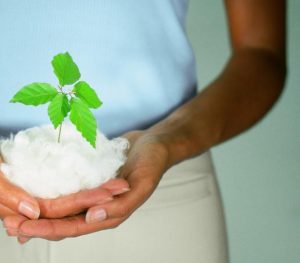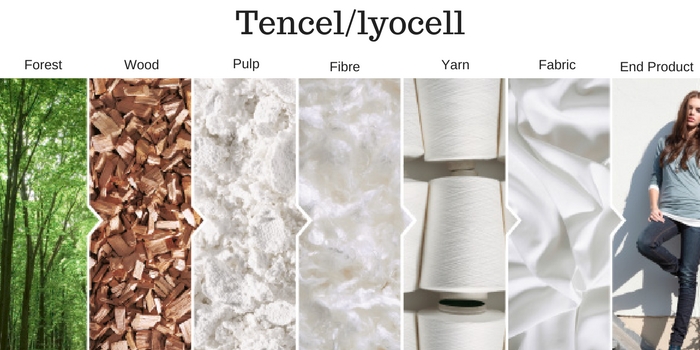We’ve certainly come into an age where the concept of slow-fashion and sustainability are really taking off, making on-going fabric innovation inevitable. When it comes to Tencel, what’s not to like about this easy-comfort, animal-freindly material. Familiarise yourself more and you’re sure to see why this regenerative textile is the ‘new black’ of fabric innovation!
Here’s my easy guide to understanding Tencel:
Synthetic vs. regenerative fabrics:
Tencel/lyocell is a man-made fabric but NOT a synthetic. (Synthetics are made from petroleum; crazy right?) This is because Tencel or lyocell is regenerated from wood cellulose, making it a sustainable fibre.
Tencel vs lyocell:
Tencel® is a brand name and lyocell is the generic name. Technically a fabric must contain 30% of the proprietary (Tencel) fibres in order to use the name Tencel.
Which to buy; Tencel or lyocell?
I’d recommend looking for the 100% TENCEL® brand, to ensure the smallest possible ecological footprint. This is because while the process to produce fibre strands from wood pulp are very similar, regardless of source, the methods used to transform these fibres into yarn, fabric, and finished products can vary a lot. Strong chemicals may be used in this process, rendering the fibre less sustainable and potentially more toxic.
Aesthetic diversity:
Today we’re seeing a lot of denim type styles and shades that are made from Tencel and lyocell, yet this material can be dyed many colours, and can simulate a variety of textures such as suede, leather, and silk.
Benefit of wearing Tencel/lyocell:
- Absorbent: The textile controls and regularly absorbs moisture (perspiration), 50% more than cotton and even more than wool. How: It is composed of very small fibres (nanofibrils) which are hydrophilic (a strong attraction to absorb water) and optimise absorption of moisture with excellent cooling properties by releasing moisture to the air.
- Odour resistant: Basically, bacterial growth is prevented through the moisture management of the fibre. When we sweat it is directly absorbed from the skin and transported to the inside of the fibre. Thus no water film is produced on the skin where bacteria could grow. Yet Tencel clothes remain odour free for multiple wearings much longer than cotton.
- Hypoallergenic: This material is not likely to cause an allergic reaction in sensitive individuals. It is also anti-static and doesn’t cling.

Taking care of your Tencel:
Because Tencel/lyocell remains odour free for multiple wears, this means fewer washings and saving on water and energy, as well as on the wear and tear that occurs on any fabric from the washing and drying processes. After wearing your Tencel garment, simply place on a hanger and let it air for sometime before it goes back into the closet. When washing is necessary, they can be hand washed or gently machine washed on a cold setting. Fabric softeners are not needed or recommended. When wet Tencel/lyocell is not soft and drapey, in fact it can feel stiff until dry. Minimal ironing is necessary, if at all, that’s a personal choice.
- Construction: Dense, tight construction minimises the amount of UV light that can pass through. Thicker fabrics also reduce UV transmission.
- Colour: Generally, darker colours absorb more rays overall, including UV rays. Within the same colour, more vibrant hues outperform paler ones.
Tencel/lyocell vs, other regenerative fabrics:
While Cupro, Modal, Viscose and Rayon are also regenerated fabrics, Tencel is one of the most environmentally-friendly regenerated fabrics, for several reasons listed below:
- Grown sustainably: Tencel’s supply chain is transparent. It is obtained from eucalyptus trees that are grown on farms, with NO old growth forests, genetic manipulation, irrigation or pesticides used.
- Nontoxic chemical: The chemicals used to produce Tencel fibres are non-toxic. So the manufacturing process avoids polluting air and water emissions, as well as avoids using catalytic agents which create strong unpleasant odours. Interesting to note too that because of the nature of the material, the processing never requires bleach.
- Processing in closed loop system: In addition, the wood pulp used for Tencel (along with Cupro and Modal) is treated in what is known as a closed loop system. Essentially this means the chemicals used can be extracted after and the water reused. 99% of the water and solvent used are recovered and reused again. This means improved water management and preservation of a vital natural resource.

Great post on one of our favorite fabrics! Taking care of lyocell properly is so important. It’s a special fabric that deserves special care.